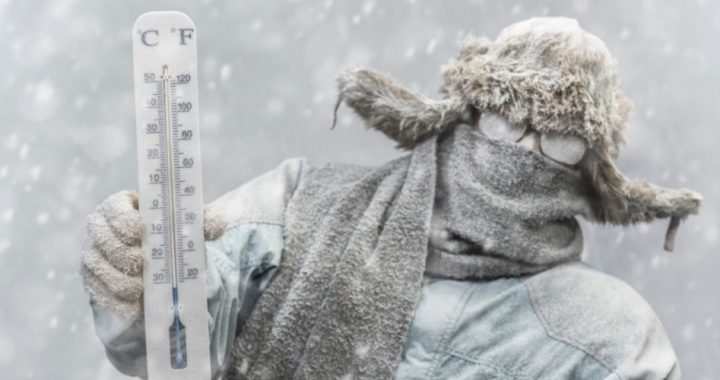
Put simply, it’s cold. But it’s not just normal winter cold. This week, much of the United States is experiencing Arctic conditions not seen in a generation. It’s all brought to you, courtesy of a phenomenon known as the polar vortex.
And global warming, of course.
The National Weather Service describes the conditions thusly. “One of the coldest Arctic air masses in recent memory is surging south into the Upper Midwest before spreading across much of the eastern two-thirds of the country. Through late week, expect frigid temperatures, bitterly cold and life-threatening wind chills, likely leading to widespread record lows and low maximum temperatures from the Upper Midwest to the Great Lakes and Ohio Valley.”
Minneapolis, no stranger to extreme cold, has closed schools through Wednesday. Chicago has already called off Wednesday classes because of the expected cold. The expected Wednesday high temperature in Milwaukee is expected to be 11 degrees below zero. And it’s windy, too. Wind chills in some areas may reach 70 below zero.
“You’re talking about frostbite and hypothermia issues very quickly, like in a matter of minutes, maybe seconds,” said Brian Hurley, a meteorologist with the Weather Prediction Center.
The conditions are unusual but hardly unprecedented. But climate alarmists have quickly moved to defend their hypothesis, saying that we can expect more of this frigid type of weather in the future due to, well, global warming.
According to Judah Cohen, a winter storm expert for Atmospheric Environmental Research (AER), unusually warm weather is causing the polar vortex to split, causing a lobe of the vortex to come south and annoy us. AER is a risk management business that consults with businesses and governments about weather and climate related risks.
“Where the polar vortex goes, so goes the cold air,” Cohen said.
The theory goes that global warming has weakened the vortex to a point where it can split more easily, causing pieces to break off more easily. A study done by global-warming hysteric Marlene Kretschmer of the Potsdam Institute for Climate Impact Research purportedly confirms this.
President Trump, for one, isn’t buying it. The president took to Twitter to troll climate alarmists. “In the beautiful Midwest, windchill temperatures are reaching minus 60 degrees, the coldest ever recorded. In coming days, expected to get even colder. People can’t last outside even for minutes. What the hell is going on with global warming? Please come back fast, we need you!”
But climate alarmists are well-schooled in making the absurd seem reasonable. “This symptom of global warming is counterintuitive for those in the cross-hairs of these extreme cold spells,” said climate scientist Jennifer Francis of the Woods Hole Research Center. “But these events provide an excellent opportunity to help the public understand some of the ‘interesting’ ways that climate change will unfold.”
Some in the media are acting like this whole polar vortex thing is brand new to us. But, actually, we’ve been down this road before. Way back in 1974, climate scientists were warning us of the effects of the polar vortex, though, back then they called it the circumpolar vortex. But in the ’70s, they told us that the expansion of that vortex was evidence of global cooling.
A Time magazine article (June 24, 1974 issue) explained that coming “climate change” (global cooling) menace to us:
Telltale signs are everywhere — from the unexpected persistence and thickness of pack ice in the waters around Iceland to the southward migration of a warmth loving creature like armadillo from the Midwest. Since the 1940s the mean global temperature has dropped about 2.7 degrees Fahrenheit.
Question. Aren’t climate scientists today using the same historical temperature data that they used in the 1970s? They tell us they are. How can that data show a large drop from the 1940s to the 1970s when we’ve been told the opposite? Were they lying to us in the ’70s or are they lying to us now? Back in February of last year, The New American reported on claims that the National Oceanic and Atmospheric Administration (NOAA) was altering historical temperature data in order to fit with the global warming hypothesis. Something stinks here.
One thing that climate scientist Jennifer Francis said about the polar vortex and the role that climate change plays in it, rings true. “It’s a complicated story that involves a hefty dose of chaos and an interplay among multiple influences, so extracting a clear signal of the Arctic’s role is challenging.”
Despite the United Nations Intergovernmental Panel on Climate Change’s (UN IPCC) announcement that we have twelve years left in order to change our way of life and stop using fossil fuels, the true fact is that we don’t have enough information to warrant such drastic measures. The Earth’s climate system is incredibly complicated. We are not even close to understanding how it all works yet, let alone acting on it in any way.
In the meantime, bundle up, folks. It’s cold out there.
Photo: cmannphoto/E+/Getty Images



